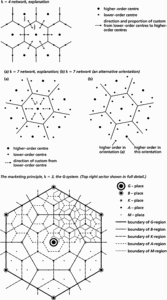A settlement or nodal point which, by its functions, serves an area round about it for goods and services. Central place theory is an explanation, advanced by W. Christaller (1933, trans. 1966), of the spatial arrangement, size, and number of settlements. Christaller modelled settlement locations in a hexagonal pattern to examine and define settlement structure and the size of the hinterland. His initial assumptions were of an isotropic plain proportional to distance; and economic man. Economic factors include demand density, economies of scope, localization economies, and agglomeration economies.
While Christaller’s theory has waned in popularity, a number of studies use central place theory; see Daniels (2006) Annal. Tourism Res. 34, 2 on central place theory and sports tourism; Dennis et al. (2002) J. Retailing & Consumer Services 9, 4 on central place theory and UK retail hierarchy; Clarkson et al. (1996) Int. J. Retail & Distrib. Manage. 24, 6 on UK supermarket location; and Dean (2003) China Qly 174 on hierarchical space in China. See also R. Schiller (2001). Taylor (2007) GaWC Res. Bull. 238 takes exception to ‘this simple equating of cities with hierarchy and competition’.


Central place theory
- degree(of a vertex of a graph)
- degree of precision
- degree of truth
- degree of truth preserving consequence
- degrees absolute
- degrees of freedom
- degrees of freedom(in mechanics)
- degrees of freedom(in statistics)
- degrees of perfection argument
- degrowth
- de gustibus non disputandum
- de Haas–van Alphen effect
- dehiscence
- Dehmelt, Hans Georg
- dehumidification
- dehydration
- dehydration curve
- dehydrogenase
- dehydrogenation
- dehydrohalogenation
- deictic
- Deimos
- deindustrialization
- deintellectualization
- deinterleaving